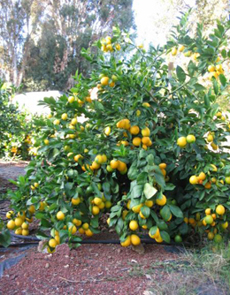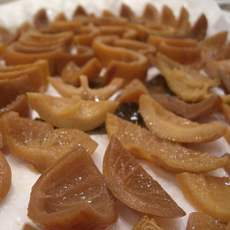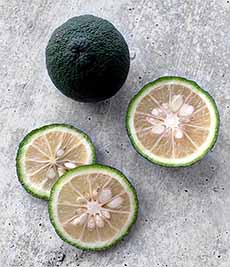

The protruding end of the lemon (opposite to the stem end) is called the nipple. The shape and length are often used to distinguish different lemon varieties. Photo by Eduardo Mancilla| SXC.
March 2010
Last Updated August 2025
|
 |
Lemon Glossary ~ Lemon Varieties
Page 4: Meyer Lemon, Preserved Lemons & Other Lemon Terms From M To Z
This is Page 4 of a five-page article about lemon varieties. Click on the black links below to visit other pages. And see many more glossaries of your favorite foods.
This glossary is protected by copyright and cannot be reproduced
in whole or in part.
MEYER LEMON
The Meyer lemon (botanical name Citrus meyeri) is not a true lemon but a hybrid between a lemon and a mandarin or other sweet orange. It was brought to the U.S. by Frank N. Meyer, an explorer for the U.S. Department of Agriculture, who found it growing as an ornamental plant in a pot in 1908, outside of Peking, China.
The Meyer lemon can be egg-shaped or rounder, with a thin, soft, and smooth light-orange rind and an orange-yellow pulp (it’s darker than a Eureka or Lisbon lemon). While the peel lacks the concentration of lemon oil of the Eureka and other standard lemons, the yellow-orange flesh is very juicy and slightly sweeter than a true lemon. Yet it’s still moderately acidic (but less acidic and bitter) than the Eureka, with a floral aroma, due to the genes contributed by the mandarin. It has a complex flavor and aroma with hints of sweet lime and mandarin. This makes it a favorite of pastry chefs for tarts and sorbets. Much of the U.S. crop of Meyer lemons is grown in California’s Central Valley, with other plantings in Florida and Texas. Unlike regular lemons, Meyer lemons are not picked green and cured after harvesting but are picked when fully ripe. They bear fruit year-round.
|
|

A Meyer lemon next to the much larger Eureka lemon (this one has a very large neck). Photo by Daniel F | SXC |
ORGANIC LEMON
Organic lemons are grown without chemical pesticides. While many people might wonder why a citrus fruit, which is squeezed for its juice, needs to be organic (as the pesticides do not penetrate the rind), there are some compelling reasons to choose organic produce. Not only do you avoid the agrochemicals in zesting the rind or using lemon peel, but organic farming means improved soil health and other environmental benefits. Read our informative article on organic versus conventional citrus.
|
|

An organic Meyer lemon tree. Photo courtesy TheLemonLadies.com. |
PONDEROSA LEMON
The bumpy Ponderosa lemon (botanical name limon × medica), which looks like a relative of the ugli fruit and just about as large (the lemon in this photo is 6 inches), is not a true lemon and is more cold sensitive than true lemons, but its fruit is similar. It is believed to be a hybrid of a lemon and a citron: While the fruit looks like a citron (bumpy peel), it tastes like a lemon. The Ponderosa lemon originated around 1887 as a chance seedling found in Hagerstown, Maryland. It was named and introduced to the nursery trade in 1900, long before the Cartwrights of the Ponderosa Ranch appeared in the 1960s. (“Ponderosa” refers to a western pine tree, which was named after the Latin word ponderosus, ponderous).
|
|

Ponderosa lemon. Photo by Kowloonese | Wikimedia. |
PRESERVED LEMON or PICKLED
LEMON
Preserved lemon is a condiment made of lemons that have been pickled in a brine of water, lemon juice, salt, and sometimes spices (they’re essentially pickled lemons). The lemons then ferment at room temperature for weeks, or even months. The result is a concentrated and earthy lemon flavor without too much tartness. Preserved lemons are popular in Mediterranean, Middle Eastern, and Moroccan cuisines and can be purchased in specialty food stores and online. Or, you can make your own with this preserved lemon recipe.
|
|

Preserved lemons. Photo courtesy Wikimedia. |
RECONSTITUTED LEMON JUICE & REAL LEMON
Reconstituted lemon juice is a processed food product, made by adding water back into concentrated lemon juice. Lemon oil is added to maintain a uniform flavor. To maintain color and freshness on the shelf, preservatives such as sodium bisulfate and sodium benzoate are typically added. Reconstituted lemon juice is not a substitute for the flavor of fresh lemons, and we avoid it. It is typically used in foodservice and bar recipes that require a large quantity of lemon juice. But the convenience is no substitute for quality. Some exceptions include the excellent Italian Volcano Lemon Burst (and Lime Burst), which come in a plastic lemon (or lime) container and are bottled fresh, not from concentrate. A separate compartment on top of the squeeze bottle contains the zest of the lemon oil from the peel, and is mixed in with each squeeze. Find out more at DreamFoods.com, and read our review of Italian Volcano juices.
SPANISH LEMON
See Verna lemon.
SWEET LEMON
Sweet lemon (botanical name Citrus limetta risso) is a term given to non-acidic lemons, or limettas. Native to Southeast Asia, it is grown in the Mediterranean and in India, and is used in local cuisine. Sweet lemon is called by a variety of additional names, including Mediterranean sweet lemon, sweet lime, and sweet limetta. Sweet lemon can be eaten as fruit (instead of juiced), and the peel contains a good amount of lemon oil.
TRUE LEMON
“True lemon” refers to an acidic juice variety of lemon, such as the Eureka or the Lisbon. These contrast with sweet lemons and non-juice citrus such as citron.
VERNA LEMON
The Verna is an acidic lemon similar to the Eureka. The fruits are large with thick skin and a few seeds; they are very juicy. The tree will normally bear fruit twice a year, but may produce a third crop of lemons if fed correctly. The Verna is of unknown origin, but has been attributed to Spain.
VITAMIN C
Mankind has historically gotten its allotment of vitamin C from fruits. Citrus fruits actually have less than other high-C fruits such as currant, kiwifruit, and papaya—see the comparative list. Vitamin C is essential for the synthesis of collagen in humans, and a deficiency causes conditions such as scurvy (spots on the skin, bleeding gums, loss of teeth, and ultimately, death). Scurvy was common among sailors, pirates, soldiers, and others at sea (or away from fresh supplies) longer than perishable fruits and vegetables could be stored; the classic diet onboard was cured and salted meats and dried grains. This problem limited ocean travel in the ancient world, and cost lives in more modern times: Vasco da Gama lost two-thirds of his crew to scurvy while making his way to India in 1499, and Magellan lost more than 80% of his crew while crossing the Pacific in 1520. A Scottish surgeon in the Royal Navy, James Lind, first proved that scurvy could be treated with citrus in 1747 and published A Treatise of the Scurvy in 1753. Typical of bureaucracies, it took Lind another 41 years (and countless suffering sailors) to convince the British Royal Navy to implement the cure.
YUZU
Yuzu is a small, round citrus the size of a key lime. Neither lemon nor lime, but able to substitute for both, yuzu is its own citrus species ( Citrus junos). It’s likely a hybrid of sour mandarin and Ichang papeda. Unlike the key lime, which has a smooth skin, yuzu has a textured skin similar to lemons, limes, and grapefruit. As with other varieties of lime, the skin color ranges from yellow to yellow-green to green. Here’s more about it.
|
|

Yuzu has many seeds, which is why it hasn’t become more popular in the U.S. (photo © Regalis Foods).
|
Continue To Page 5: Lemon Nutrition & Uses
Go To The Article Index Above
Some information courtesy Purdue University. Copyright 2005- Lifestyle Direct, Inc. All rights reserved. Images are the copyright of their respective owners.

|









